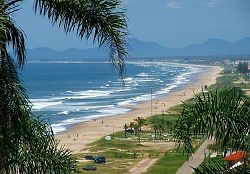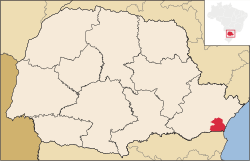This article needs additional citations for verification. (January 2011) |
Guaratuba is a city in the state of Paraná, Brazil. Founded on 1765, it is considered to be one of the most beautiful beaches of Paraná.[1]
Guaratuba | |
|---|---|
 Beach of Brejatuba | |
 Location in Paraná | |
| Coordinates: 25°54′S 48°34′W / 25.900°S 48.567°W | |
| Country | Brazil |
| State | Paraná |
| Area | |
• Total | 1,325.883 km2 (511.926 sq mi) |
| Lowest elevation | 0 m (0 ft) |
| Population (2005) | |
• Total | 34,100 |
| • Density | 26/km2 (67/sq mi) |
| Time zone | UTC−3 (BRT) |
History
editThe King of Portugal, Dom Jose I, worried about possible foreign raids on the Brazilian coast, commanded that villages and towns be established in more suitable locations to the projecting or dispersed small farms where the conditions were favourable. It was decided that a town should be founded between the villages of Paranaguá and of the River San Francisco. On 5 December 1765, Dom Luis sent a group of settlers to begin building the town. This comprised 200 couples, who would cultivate discovered lands. Thus Guaratuba began to take shape. In July 1766, the Conde de Oeiras directed Dom Luis praising, on behalf of the King, the projects to establish the population in the cove of Guaratuba and informed him that the King wished that the new village bear his name, S. Luis.
On 13 May 1768, Dom Luis granted the royal charter requested by the founder of the new town which consisted of the creation and maintenance of a church. Dom Luis, on 23 January 1770, commanded his assistant lieutenant-colonel Alfonso Botelho de Sampaio e Sousa, who erected in village the small farm called Guaratuba, where there were already houses and other buildings. After some expeditions, on 27 April 1771, Dom Luis returned to Guaratuba. On the 28th day of that month, the church was blessed and on the 29th the village of São Luís de Guaratuba was formally named. On 30 April 1771, the first city council was elected with the approval of the founder of the village and the provincial governor. The councillors thenceforth guided the fortunes citizens of Guaratuba, subject to the authority of the provincial governor (up to 1854 Paraná belonged to the province of São Paulo), until the declaration of the republic, when a new political system canme into effect. Its first elected mayor took office in 1792, thus continuing up to 20 of October 1838, when by the Act No. 7572, the city ceased to exist in its former status and was constituted as the municipality of Paranaguá. It was not until 10 October 1847, by the Act No. 02 of that year, that the city regained its independence, being reinstalled on 25 of October of the same year. In this new phase, the first mayor was Mr. Berilo da Cunha Padilha. In 1954, the city of Guaratuba became part of the Jurisdiction of Sao Jose dos Pinhais. Finally in July 1986 Guaratuba obtained municipal independence.
Geography
editThe Guaratuba name means "many guarás". This name was conceived by the natives who inhabited this region at the time of the discovery of Brazil by the Portuguese people. Guará is the name of a bird of red plumage that existed in abundance in this area and even though protected by the authorities, they became extinct. Tuba means extreme amount in the aboriginal language.
The municipality contains 67% of the 199,587 hectares (493,190 acres) Guaratuba Environmental Protection Area, created in 1992.[2] It contains the 6,052 hectares (14,950 acres) Boguaçu State Park, created in 1998.[3] It also contains about 67% of the 49,287 hectares (121,790 acres) Guaricana National Park, created in 2014 to protect a mountainous area of Atlantic Forest.[4] It contains the Lagoa do Parado Municipal Nature Park, which protects an area of marshland rich in biodiversity.[5]
Geographic position
editThe geographic position of Guaratuba is the following: Altitude - 6 meters, Latitude - 25° 52', Longitude - 48° 34'. The city is situated in a peninsular, arenaceous plain, facing the bay at the Northwest, and another front in the Atlantic Ocean at the Southeast.
Climate
editThe climate of Guaratuba is subtropical and humid, without definite dry station and exempt of frosts. The average of temperature of the hottest months is superior 30 °C, and in the most cold months over 15 °C.
Economy
editAgriculture, fishing, and the tourism constitutes the basic economic activities of the city. Guaratuba has fertile lands where maize, sugar cane, rice, oranges, ginger and bananas, and many other products are of great economic importance. The cattle is distinguished with a considerable herd of buffaloes. Fishing also has great prominence in the economy of city, being one of its main sources of wealth, being made in an artisan way. Even with its fishing being done in artisan way, the technology already is present in 80% of this activity operating with a fishing industry.[citation needed] Two industries of palmito still exists in Guaratuba that are marks in Brazil and the exterior.[clarification needed] The tourism also constitutes excellent source of profit for the city. Tourists from many different places in Brazil and the world visit annually its 27 km of beaches.
Demography
editWith an estimated population of 34,100, Guaratuba is the second largest city of the Paraná coast, second only to Paranaguá.
Highways
editThe main highways are: BR-376 (it binds Curitiba to the South of Brazil) and PR-412 (it binds Pontal do Paraná to Guaratuba).
Beaches
editCaieiras Beach
editThe Caieiras beach is located between the tip of the Johnnser and the rocks of the Caieiras, it has an extension of 1 km, and is used for a community of fishermen. A curiosity on this beach is a Paraguayan steamer that sunk when it escaped from the Brazil-Paraguay war.
Hotel Beach
editThe Hotel beach is initiated in the rocks of the Caieiras until the Hotel; its extension is in format of a half moon and follows to the Mount of the Christ.
Central beach
editThe Central beach starts in the Beach of the Hotel and goes until the Mount of the Christ, forming the Turkish Beach, the fishermen beach and the Beach of the Christ.
Brejatuba Beach
editThe Brejatuba beach is located to the south of the Mount of the Christ, in its extension receives many names.[clarification needed] It is good for bath, surf and fishing.
Prainha
editPrainha is located in the tip of Caiobá, before the passage of the bay.
Bay of Guaratuba
editThe Bay of Guaratuba, second greater of the state,[clarification needed] with an exuberant beauty with beautiful islands and rivers. Rich in fauna and flora, the area is under protection.
References
edit- ^ http://www.guaratuba.pr.gov.br
- ^ APA Guaratuba (in Portuguese), ISA: Instituto Socioambiental, retrieved 2016-11-19
- ^ Jaime Lerner (26 February 1998), Decreto nº 4.056 de 26 de Fevereiro de 1998 (PDF) (in Portuguese), retrieved 2016-09-20
- ^ PARNA Guaricana – ISA.
- ^ "Lagoa do Parado: uma reserva biológica no litoral Paranaense", Tribuna/PR, 25 January 2005, retrieved 2016-11-19
Sources
edit- PARNA Guaricana (in Portuguese), ISA: Instituto Socioambiental, retrieved 2016-06-16
